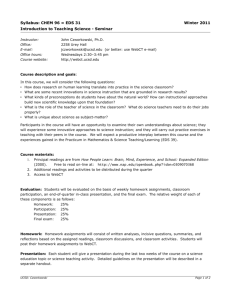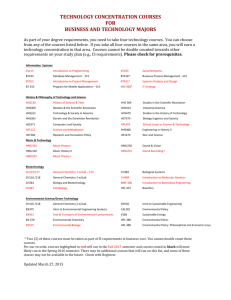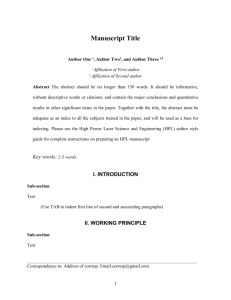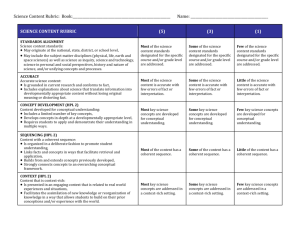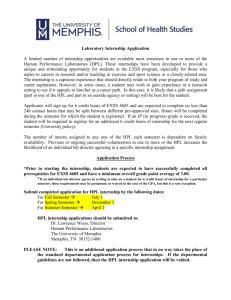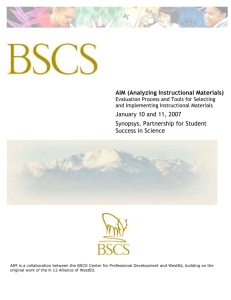Adams/Car Tutorial Modifying Suspension Hardpoints Overview In
advertisement
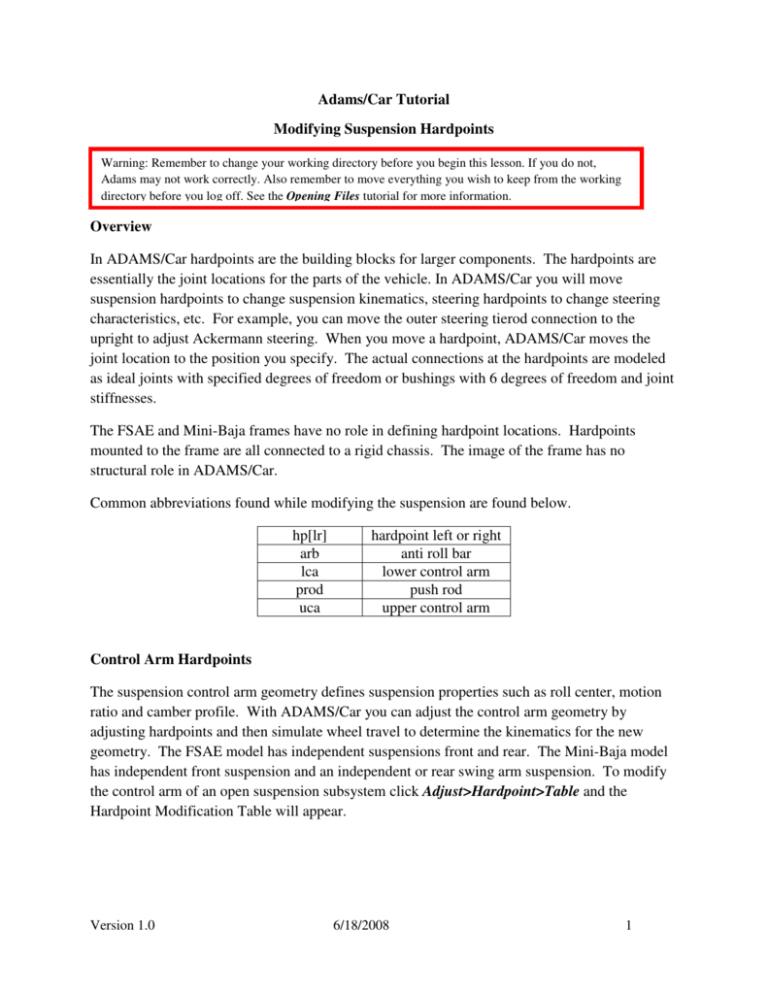
Adams/Car Tutorial Modifying Suspension Hardpoints Warning: Remember to change your working directory before you begin this lesson. If you do not, Adams may not work correctly. Also remember to move everything you wish to keep from the working directory before you log off. See the Opening Files tutorial for more information. Overview In ADAMS/Car hardpoints are the building blocks for larger components. The hardpoints are essentially the joint locations for the parts of the vehicle. In ADAMS/Car you will move suspension hardpoints to change suspension kinematics, steering hardpoints to change steering characteristics, etc. For example, you can move the outer steering tierod connection to the upright to adjust Ackermann steering. When you move a hardpoint, ADAMS/Car moves the joint location to the position you specify. The actual connections at the hardpoints are modeled as ideal joints with specified degrees of freedom or bushings with 6 degrees of freedom and joint stiffnesses. The FSAE and Mini-Baja frames have no role in defining hardpoint locations. Hardpoints mounted to the frame are all connected to a rigid chassis. The image of the frame has no structural role in ADAMS/Car. Common abbreviations found while modifying the suspension are found below. hp[lr] arb lca prod uca hardpoint left or right anti roll bar lower control arm push rod upper control arm Control Arm Hardpoints The suspension control arm geometry defines suspension properties such as roll center, motion ratio and camber profile. With ADAMS/Car you can adjust the control arm geometry by adjusting hardpoints and then simulate wheel travel to determine the kinematics for the new geometry. The FSAE model has independent suspensions front and rear. The Mini-Baja model has independent front suspension and an independent or rear swing arm suspension. To modify the control arm of an open suspension subsystem click Adjust>Hardpoint>Table and the Hardpoint Modification Table will appear. Version 1.0 6/18/2008 1 Below are the hardpoint tables for the FSAE and Mini-Baja front suspensions with the upper and lower control arm hardpoints highlighted. Version 1.0 6/18/2008 2 Mini-Baja Swing Arm The swing arm found on the Mini-Baja can not be simulated by its self. A full vehicle assembly must be opened to simulate swing arm motion. Pushrod, Bellcrank & Shock Hardpoints (FSAE) When modifying the bell crank placement on the FSAE model you must enter the position of the joint connection to the chassis (hpl_bellcrank_pivot) and a point to define the rotation axis (hpl_bellcrank_pivot_orient). The other points defining the bell crank are the pushrod, anti-roll bar and shock connections (hpl_prod_to bellcrank and hpl_shock_to_bellcrank). The connection of the pushrod to the upright is hpl_prod_outer. The shock connection to the chassis is hpl_shock_to_chassis. If you wish to design a pullrod suspension converting the pushrod system is simply a matter of changing the geometry of the components. The image of the bellcrank is defined by the positions of the bellcrank pivot, pushrod location, and anti-roll bar. When these connections move the image of the bellcrank will update. The Mini-Baja has a simpler suspension design and the shocks mount directly to the control/swingarm and chassis. The shock is modeled with two hardpoints; one to the control arm or swing arm and one to the chassis. Anti-Roll Bar Hardpoints (FSAE) The hardpoints of the anti-roll bar geometry is modified using the fsae_front_arb subsystem with the exception of the connection to the bell crank (hpl_ arblink_to_bellcrank) which is modified on the fsae_front_susp subsystem. The anti-roll bar bushing mount (hpl_arb_bushing_mount) is listed in the fsae_front_susp subsystem but cannot be modified there. You will need to move the hardpoint hpl_arb_bushing to coincide with the anti-roll bar system to insure the system works properly. Having hardpoints hpl_arb_bushing and hpl_arb_bend at the same point works well. Version 1.0 6/18/2008 3 hpl_arblink_to_bellcrank hpl_droplink_to_arb hpl_arb_bushing hpl_arb_middle hpl_arb_bend Steering Hardpoints In the FSAE steering system the steering rack placement is defined by the location of the inner tierods found on the front suspension subsystem. When the inner tierod positons move the rack moves with them. The pinion and rack do no have to coincide to work properly. ADAMS uses input and output communicators to relay the displacement information. The model has two joints between the steering wheel and pinion, and can be placed with creating an angle between intermediate shafts. Version 1.0 6/18/2008 4 Steering intermediate joints The Mini-Baja steering shaft must be straight from the pinion (hps_pinion_pivot) to the steering wheel center (hps_steering_wheel_center). Between the pinion and steering wheel center are two intermediate points (hps_intermediate_shaft_forward and hps_intermediate_shaft_rearward). You will need to move these points to create a straight steering shaft from the steering wheel to the pinion. The shaft must be straight in order for the steering to work properly. In the template the pinion and rack are coincident. This does not have to be the case. You could move the steering rack and inner tierods forward and leave the pinion Version 1.0 6/18/2008 5 and steering shaft in its original position. There does not have to be a visible connection between the pinion and the rack. Pinion and rack are coincident in template hps_intermediate_shaft_forward hps_intermediate_shaft_rearward Version 1.0 6/18/2008 6 Modifying the FSAE Front Suspension Obtain and save the FSAE template. Open ADAMS/Car and add the database to the session by clicking Tools>Database Management>Add to Session. Navigate to the location you have saved the FSAE template to add. Open the FSAE front suspension assembly by clicking File>Open>Assembly. Navigate to the FSAE assemblies.tbl folder and select fsae_front_with_steer. The default units for the FSAE model are millimeter, kilogram, and newtons. Change the units to inches, pounds mass, and pounds force by going to Settings>Units. Version 1.0 6/18/2008 7 Click the IPS button at the bottom of the window to change the units. Click OK. Version 1.0 6/18/2008 8 From the menu select Modify> Adjust> Table. The Hardpoint Modification Table will appear. Click the arrow in the top center to see the subsystems that have hardpoints that you can adjust. Notice the front suspension, steering, and anti-roll bar subsystems make up this assembly and have hardpoints you can modify. The origin for the assembly is at an arbitrary location. Placement of the hardpoints will need to be made relative to other hardpoints in the suspension. Subsystems Hardpoints to show Version 1.0 6/18/2008 9 At the bottom left of the Hardpoint Modification Table you have the option to view the left, right, or both sides of the vehicle. If left or right is selected then you will be entering changes for that side of the vehicle but changing both sides symmetrically. To modify the hardpoints for the front suspension make sure fsae_front_susp is selected and simply enter a new value for the loc_x, loc_y, or loc_z positions. Then click OK or Apply to make the changes. Six points determine the control arm geometry at one wheel. For the upper and lower control arms there are outer, front and rear hardpoint locations. The names for theses hardpoints are hpl_lca_front, hpl_lca_outer, hpl_lca_rear, hpl_uca_front, hpl_uca_outer, and hpl_uca_rear. New position values can be entered into the table. Looking at the model space, notice the coordinate axes at the bottom left-hand corner of the window has the positive x-direction towards the rear and the positive y-direction towards the right from the driver’s perspective. Obtain a front view of the assembly by right clicking on the workspace and selecting Front. With the Hardpoint Modification Table open change the loc_y values for hpl_uca_front and hpl_uca_rear from -7.876 to -12 and click Apply. Notice that the inboard upper control arm connections have been moved outward from the center of the vehicle thus shortening them. Version 1.0 6/18/2008 10 Now adjust the outboard lower control arm connection changing both the kingpin and caster angles. Reduce the kingpin angle by making the loc_y value for hpl_lca_outer -26 and observe the change in kingpin. Now obtain a side view of the assembly by holding “r” + left mouse button to rotate. Change the loc_x position for hpl_lca_outer to -23, click Apply and observe the increase in caster angle. The pushrod, bellcrank, and shock parts in the template are not planar at the design position and the pivot orient is not perpendicular to the face of the bellcrank. Make the following changes to the system to create a planar system with a perpendicular pivot orient. When done making changes click Apply. Rotate the system to confirm the pushrod, bellcrank, and shock are planar. hpl_prod_outer (-18.2, 27.1, 0.1), hpl_prod_to_bellcrank (-17.2, -9.9, 17.4), hpl_ bellcrank_pivot (-14.2, -10, 17.1), hpl_bellcrank_pivot_orient (-14.6, -2.9, 10.1), hpl_shock_to_bellcrank(-15.2, -8.3, 18.9), hpl_shock_to_chassis (-5.2, -8, -18.7), hpl_arblink_to_bellcrank( -15.2,-8.3,-18.9). Version 1.0 6/18/2008 11 Adjust the steering tierod by making the following modifications. Click Apply and notice that the steering rack moves with the placement of the inner tierod. hpl_tierod_inner (-14, -12, 3), hpl_tierod_outer (-18,-23, 3) Move the wheel center to the following position. Click Apply and observe the change in wheel position. hpl_wheel_center (-21.5 -27.6, 6) Select the anti-roll bar subsystem in the Hardpoint Modification Table. View the anti-rollbar subsystem be clicking View>Subsytem, and selecting fsae_front_arb. To insure the system works properly you will need to move the hardpoint hpl_arb_bushing to coincide with the antiroll bar system. Move the anti-roll bar to the following positions and click Apply. hpl_arb_bend (-20.2, -8.3, 23), hpl_arb_bushing (-20.2, -8, 23), hpl_arb_middle (-20.2, 0, 23), hpl_droplink_to_arb(-20.2,-8.3,-18.9) Additional Information: There are a few points in the Mini-Baja suspensions that are not used directly for the suspension. The front suspension has drive shaft and subframe mounts. The drive shaft is used in the rear suspension. These hardpoints are not used Mini-Baja front suspension Version 1.0 6/18/2008 12 These hardpoints are not used Mini-Baja rear suspension Warning: Remember to change your working directory before you begin this lesson. If you do not, Adams may not work correctly. Also remember to move everything you wish to keep from the working directory before you log off. See the Opening Files tutorial for more information. Version 1.0 6/18/2008 13
